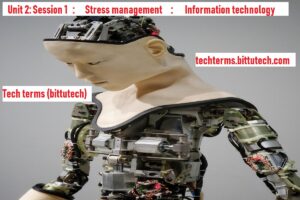Important Points-:
- A computer-based record-keeping system is known as DBMS – Database Management System.
- Duplication of data is known as Data Redundancy.
- Multiple copies of the same data that mismatch, are known as Data Inconsistency.
- A Storage container storing data pertaining to a simple object, subject, or purpose is known as
- A field that uniquely identifies records in the table is known as Primary Key.
- A statement that gives you filtered data according to your conditions and specifications, is called Query.
- An interface in a user-defined layout that lets users view, enter, or change data in tables, known as Forms.
- A formal, presentable printed document that lists data in a formatted way is known as Reports.
- Named collection of fields that represents a complete unit of information is called Records.
- A row in a table is also known as a tuple.
- The field holds a single piece of data.
- A field that contains unique data in each record is known as the Primary key.
- The Foreign key is a field that stores values coming from the primary key of another table.
- When a primary key contains more than one field, it is known as the composite key.
- The Tables are the main building blocks of the database.
- It consists of separate tables of related data describe a relational database.
- A Database table should always contain a key field.
- Data in the database is stored in a Table.
- A collection of data that is stored in a logical structure is known as the database.
- One piece of data about a single person or thing is known as a field.
- All of the information about one person or one thing is known as a record.
- A collection of records on a particular topic is stored as a Table.
- To find a particular record or set of records in a database you would use a query.
- To organize the different tables of related data, a relational _database_ is used.
- To display data in a specific format or distribute a summary of data, reports are created.
- To get data input from the user in a well-organized, formatted way on screen, _ forms_ are used.
- In the database view of a relational database, a row of information is called a _tuple._.
- To control how information is entered into a database, programmers, and database administrators create _forms to help ensure data integrity.
- In a relational database, a common field that links two tables in a relationship but not a primary key is called a _foreign_ Key.
- The database uses common fields to create links between tables. Thus such databases are called _relational_ databases.
- A primary key is used to _uniquely_ identify the record in a table.
- The Database_ is a collection of related information.
**Questions and Answers**
What is Database?
A database is a collection of logically related data. The database stores the data in an organized and well manner form.
What do you understand by Data Inconsistency?
Data inconsistency is a situation where there are multiple tables within a database that deal with the same data but may receive it from different inputs. Inconsistency is generally compounded by data redundancy.
What is meant by Data Redundancy?
Data redundancy occurs when the same piece of data exists in multiple places.
Write the key features of a DBMS?
There are various key features of a database management system. some major features are as follows-
- Data Availability
- Minimized Redundancy
- Data Accuracy, Consistency and Relevance
- File Consistency
- Improved Data Security
Write the basic features of OOo BASE?
The basic features of OOo base are :-
- It has a word processor analogous to Microsoft Word or WordPerfect.
- It has a presentation program analogous to Microsoft PowerPoint or Apple Keynote. This system is called Impress which can trasport presentations to Adobe Flash (SWF) files . And this system will allow them to play on any computer with a Flash player facility.
- It has a feature OOo 3 Math icon which is for creating and editing mathematical formulas . And also analogous to Microsoft Equation Editor.
- It has a database management program analogous to access Microsoft. Which includes Access databases (JET), ODBC data sources, MySQL and PostgreSQL.
How do you interpret ‘Field‘ in context of a DBMS?
When we talk about field in the context of DBMS, it is actually referring to a unique single unit of data in a particular row. For example, in a student roll call data, the categories will be first name, last name, and roll number.
What is a primary key? What is an alternate key?
Primary Key -: It Contain one or more columns whose combined values uniquely identify every row in a table. Each table can have only one primary key.
Alternate Key-: Alternate Key or Secondary Key is the key that has not been selected to be the primary key, but are candidate keys. However, it is considered a candidate key for the primary key. A candidate key not selected as a primary key is called alternate or secondary key.
What is the need of setting relationships between tables?
A relationship works by matching data in key columns, usually columns (or fields) that have the same name in both tables. In most cases, the relationship connects the primary key, or the unique identifier column for each row, from one table to a field in another table. There are various forms of relationships occurred.
What is a DBMS? What importance does it have for an enterprise?
A database management system is an important tool for enterprise organizations that operate digitally and rely on consistent, clean data to make decisions. While databases are essential for data storage, it’s the DBMS that serves as a catalyst for modifying, managing and making use of company data.
What are the advantages of DBMS over a normal file system?
There are several advantages of Database management system over file system. Few of them are as follows:
- No redundant data: Redundancy removed by data normalization. No data duplication saves storage and improves access time.
- Data Consistency and Integrity: As we discussed earlier the root cause of data inconsistency is data redundancy, since data normalization takes care of the data redundancy, data inconsistency also been taken care of as part of it
- Data Security: It is easier to apply access constraints in database systems so that only authorized user is able to access the data. Each user has a different set of access thus data is secured from the issues such as identity theft, data leaks, and misuse of data.
- Privacy: Limited access means the privacy of data.
- Easy access to data – Database systems manage data in such a way so that the data is easily accessible with fast response times.
- Easy recovery: Since database systems keep the backup of data, it is easier to do a full recovery of data in case of a failure.
- Flexible: Database systems are more flexible than file processing systems.
What are – forms, queries and reports in BASE?
- Forms -:A form is a database object that you can use to enter, edit, or display data from a table or a query.
- Queries -: a query means a request for information. A query is a way of requesting information from the database. A database query can be either a select query or an action query. A select query is a query for retrieving data, while an action query requests additional actions to be performed on the data, like deletion, insertion, and updating.
- Reports -: A database report is the formatted result of database queries and contains useful data for decision-making and analysis. Most good business applications contain a built-in reporting tool.
How is a relational database different from a flat database?
A flat file database stores data in a single table structure. A relational database uses multiple table structures, cross-referencing records between tables. Tables in both organize records in rows, with each column containing a single piece of data in the record.
Name different types of keys in a table.
There are mainly seven different types of Keys in DBMS and each key has it’s different functionality:
- Super Key – A super key is a group of single or multiple keys that identifies rows in a table.
- Primary Key – is a column or group of columns in a table that uniquely identifies every row in that table.
- Candidate Key – is a set of attributes that uniquely identify tuples in a table. Candidate Key is a super key with no repeated attributes.
- Alternate Key – is a column or group of columns in a table that uniquely identifies every row in that table.
- Foreign Key – is a column that creates a relationship between two tables. The purpose of Foreign keys is to maintain data integrity and allow navigation between two different instances of an entity.
- Compound Key – has two or more attributes that allow you to uniquely recognize a specific record. It is possible that each column may not be unique by itself within the database.
- Composite Key – An artificial key that aims to uniquely identify each record is called a surrogate key. These kinds of keys are unique because they are created when you don’t have any natural primary key.
- Surrogate Key – An artificial key that aims to uniquely identify each record is called a surrogate key. These kinds of keys are unique because they are created when you don’t have any natural primary key.




